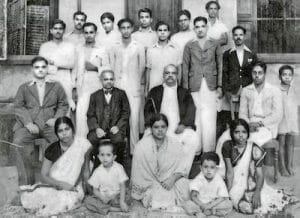Pradeed K
More than any other epidemic, Cochin was ravagedby smallpox, from very early times. And during such periods it used to take a heavy toll of life. Some time in 1930s, an elderly member of the Edappally royal family, the Elangallur Swarupam, was infected by the disease. The then Chief Physician and Sanitary Medical Officer found it was beyond him to treat the patient and washed his hands off the case. The desperate family rushed the patient to the homoeo dispensary and college that functioned out of a small building at Market Road, Ernakulam. And he was saved.
A college and a dispensary

The grandfather of the two brothers, Naga Padiar, hailed from Ratnagiri in Maharashtra. It is said he was found sleeping in front of a shop at Mattancherry along with his brother whose name is not known but fondly called Cherdu (meaning child). They had nothing except their clothes on them. The brothers were given asylum, they found work here and raised their families. This was the beginning of the Padiar family. Naga Padiar’s son Krishna Padiar was a small-time businessman who went broke, Sreenivasa Padiar (SK) and Madhava Padiar (MK) were his sons.
“MK studied at Santa Cruz school in Fort Kochi, then British Cochin and for a year worked at the post office there. This was a post usually reserved for someone who could read, write and spoke English well. MK studied homoeopathy in Calcutta and started a dispensary on New Road, Mattancherry. He was a bachelor who stayed in a small room behind the dispensary. SK first served as a teacher at TD School, Mattancherry, and later at Ammembal Subraya Pai Memorial School at Ernakulam. He also did his homoeopathy course from Calcutta. While MK was more of a practitioner, SK was a teacher at heart. The idea of starting a college was SK’s,” informs Dr. Naresh Padiar, grand-nephew of MK Padiar.
The college and dispensary at Ernakulam and MK Padiar’s place at Mattancherry soon became very popular for its systematised courses and treatment methods. Veteran CPI (M) leader MM Lawrence remembers going to the Ernakulam dispensary with his father and younger brother. “I must have been around five years old then and my brother two years younger. He had a skin ailment. SK Padiar examined him and in the process noticed a hard lump on his back. We returned with medicines and by the end of the prescribed course my brother’s ailment became worse and the lump softened. When we rushed back to meet the doctor he said calmly that now everything was fine. A new set of medicines were prescribed and by the end of that course both the skin ailment and the lump had vanished.”
The dispensary was a welcome refuge for Lawrence and other comrades when they had to go underground in the 1940s fearing persecution and arrest. “Viswanatha Menon developed a painful cyst on his back. It needed immediate treatment. So one night, when the city was asleep, we went to Padiar’s dispensary. The medicines he administered were so effective and he was cured soon. I was a sort of ‘regular’ there,” says Lawrence.
Famous student
Among the early students at the college was KR Gowry, the elder sister of former Indian president KR Narayanan. “Gowry was a student of the college’s early batches. She had to stay in Ernakulam but found that no one was ready to accommodate her as she belonged to a socially marginalised community. SK Padiar allowed her to stay in the college building, in a small room adjoining the hall that was the dispensary. Gowry completed her course but since the certificate restricted her from practising in Travancore, I think she did not pursue homoeopathy as a career,” says Naresh Padiar, a dermatologist who is also a practising homoeopath.
Pulling out a sheaf of photocopies from a brown cover, which Naresh Padiar hands over. “This is The Homoeopathic Recorder that used to be published from Philadelphia. Take a look at this article by MK Padiar that appeared in the issue dated June 15, 1926, on a case of hysteria that he cured. I think it is unique because it was so tough to get published in this periodical. It took nearly two months to be processed. It is some proof of MK Padiar’s erudition.”
From 1920 to 1978 the college and dispensary functioned at Market Road, Ernakulam. In 1966 the management purchased land at Chottanikkara and the dissection hall was set up here the same year. In 1975 the foundation stone for the college building was laid by NK Balakrishnan, the then Minister of Health, Kerala. In 1979, the college was shifted to the new premises. By then the ownership was transferred to a public trust and later to the Kashi Math Samsthan, Varanasi. Today, the full-fledged college with all facilities is affiliated to Kerala University of Health Sciences, Thrissur, and recognised by the Central Council of Homoeopathy, New Delhi.
Now renamed Dr Padiar Memorial Homoeopathic Medical College, one of the oldest colleges of its kind in the country, is a living tribute to the two Padiar brothers.
Source : http://www.thehindu.com/life-and-style/homoeopathy-in-kerala-and-the-padiar-family/article23709509.ece
Photo credit : Hindu Newpaper

Be the first to comment